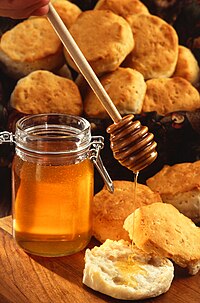
Photo from wikipedia
Antibacterial activity is the most investigated biological property of honey. The goal of this study was to evaluate the antibacterial activity of 57 Slovak blossom honeys against Staphylococcus aureus and… Click to show full abstract
Antibacterial activity is the most investigated biological property of honey. The goal of this study was to evaluate the antibacterial activity of 57 Slovak blossom honeys against Staphylococcus aureus and Pseudomonas aeruginosa and investigate the role of several bioactive substances in antibacterial action of honeys. Inhibitory and bactericidal activities of honeys were studied to determine the minimum inhibitory and bactericidal concentrations. The contents of glucose oxidase (GOX) enzyme, hydrogen peroxide (H2O2), and total polyphenols (TP) were determined in honeys. We found that honey samples showed different antibacterial efficacy against the tested bacteria as follows: wildflower honeys > acacia honeys > rapeseed honeys. Overall antibacterial activity of the honeys was statistically-significantly correlated with the contents of H2O2 and TP in honeys. A strong correlation was found between the H2O2 and TP content. On the other hand, no correlation was found between the content of GOX and level of H2O2. Antibacterial activity of 12 selected honeys was markedly reduced by treatment with catalase, but it remained relatively stable after inactivation of GOX with proteinase-K digestion. Obtained results suggest that the antibacterial activity of blossom honeys is mainly mediated by H2O2 levels present in honeys which are affected mainly by polyphenolic substances and not directly by GOX content.
Journal Title: Molecules
Year Published: 2019
Link to full text (if available)
Share on Social Media: Sign Up to like & get
recommendations!